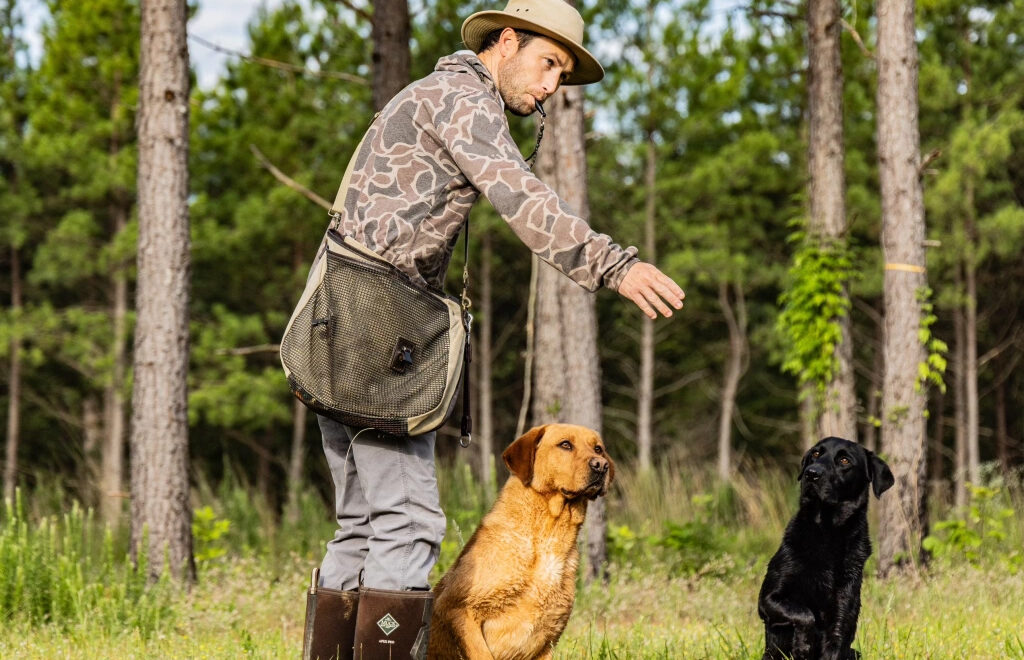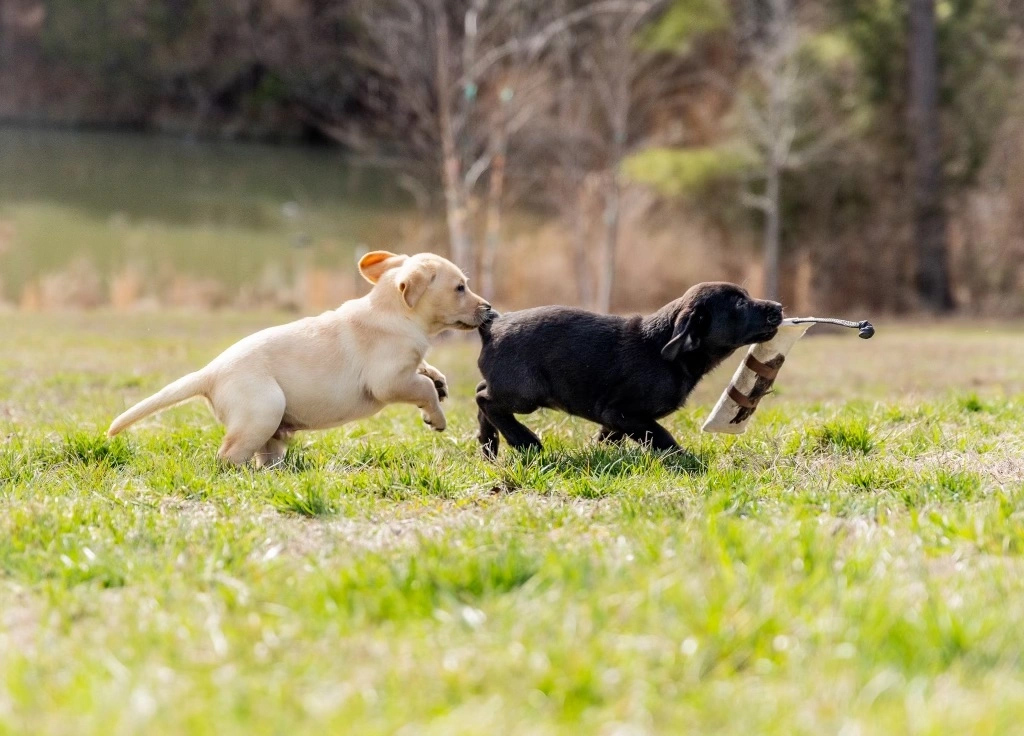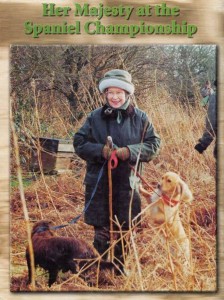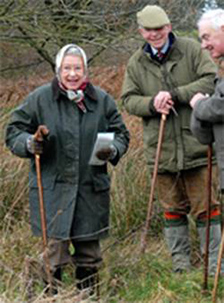Follow the Leader: Monkey See, Monkey Do

By Steven Lucius, Wildrose Carolinas
Photos by Tennent Rich
As new dogs arrive for training at Wildrose, our experience has been that there are several common issues likely to be present. Some issues are more challenging than others. What is the best solutionist approach to meet these challenges while training in a balanced way?
Seven months of age is the perfect time to begin a pup’s formal basic gundog or adventure dog training as they are mature enough to comprehend the lessons and their adult teeth have arrived making it appropriate to begin hold conditioning soon, but first the retrieve drive should be evident. Actually, hold conditioning can’t begin if the pup has no desire to pick up the bumper, get into the water or simply complete the short retrieve without getting distracted. How do we address the reluctant beginner the positive way?
Learning through Group Dynamic Conditioning
Enter stage left is Wildrose Ivy, my 11-year-old black lab female assistant trainer who wants nothing but to please while avoiding anything negative. The positive influence that comes over the reluctant younger dog when he/she is ignored during a training session and sees, hears, and feels all the praise from the handler going to the older dog’s performance is amazing and most often motivational. This is Group Dynamic Conditioning, which has so many benefits that it’s hard to count all the positive results that can be reciprocated by simply working a problem pup simultaneously with an older dog who performs the skills and behaviors correctly with confidence and enthusiasm. Such stimulus is contagious, and it can quickly influence the young prospect’s learning. The student will want to join the action and receive the praise that is being embellished upon the senior dog doing the work. The more times you hold the reluctant young pups back to sit and watch the enjoyable activity demonstrated by the older influencers, the flame that’s been there all along begins to grow. The pup wants to join to also receive praise. Simply, this is the Pack Mentality used to our training advantage to solve problems.
Group Dynamic Conditioning can also help settle and quieten the dog who persistently makes noise due to impatience or the jealousy of watching another dog work. Many gundogs are not accustomed to sitting on the sidelines and not be the star running the ball down the field. Patience is an acquired trait. A dog’s whining or being vocal is never welcomed during training or in the duck blind when there is lively action occurring. The best correction for a “squeaky” retriever is a psychological one, not a physical one. Dogs are pack-oriented so using Group Dynamics with consistency in your problem-solving activities can be powerful. Removing the vocal dog from the training group (who are displaying appropriate behaviors) at the exact moment the dog becomes vocal, walking away with the dog giving a verbal “NO,” then stopping a distance away from the activity to allow the dog to watch is an appropriate correction. The removal from their pack is punishment (denying where the dog wants to be) and the distance reduces the stimulus. If another noise results, continue to extend the distance further away from the action. Repeat as necessary. Continue this process until a distance is reached, away from the action, and the dog settles, perhaps even letting out a deep breath and watches without making a sound. This is the time to respond with verbal praise. When patience is displayed by our dog, begin strategically moving back towards the training activities. At any point the nosiness returns, stop and move further away once again. Through consistency and timing the “NO” correction for the noise and the praise for the correct behavior, the dog will begin to understand that unwanted behavior results in their removal from their pack and the fun. Soon the noisy student will conform to the desirable behaviors displayed by the group that gets the rewards.

One may question, “why is my young dog continuing to drop the bumper/ball at my feet every time I send him for a retrieve?” This behavior was possibly allowed and became a habit as a puppy with chew toys or having possessions in the backyard. The question now becomes “how can this be fixed without putting heavy pressure on the pup that may cause a shut down causing the youngster to avoid retrieving altogether?” Group Dynamics, training with an older dog who delivers the bumper will be an excellent option to help modify the behavior of dropping to delivering to hand. Ivy is great when I’m at this point with a dog in training. She sits quietly by my side while the adolescent pup makes the retrieve. Upon returning with the bumper, the pup is out of control running as hard as he can and as he gets closer, he drops the bumper at my feet. How I respond can have a positive or negative effect on that pup’s desire to bring that bumper to me. The response: simply get control of the pup’s collar and most importantly say nothing to him. We don’t want to praise him for doing something the wrong way. Pay attention to how you are communicating with your pup. Once I have control, I will release Ivy to pick the bumper up at my feet and bring it to me. My praise will only be directed to Ivy while ignoring the younger pup completely. Over time our student will start to figure out what Ivy is doing to receive all the desirable praise. This is a positive and neutral response only, no corrections to your young pup’s actions as he figures his way through training and preventing negative pressure that could shut down the young dog’s retrieve drive or result in avoiding returning.
Another situation is if some sensitivity is noticed the first time I introduce gunfire using a .209 primer pistol during a training session, Group Dynamics can help build the dog’s confidence by assisting the young dog in becoming less sensitive to the shot or not reacting to the anticipation of the noise. Dogs are naturally competitive pack animals. The energy level and confidence portrayed from the experienced dog is a powerful aspect that you may not realize as well as the understanding of the communication that is continuously occurring within your pack from canine to canine. The confidence that can be learned in certain training situations from Group Dynamics can create learners who will believe in themselves during those highly stimulated, new situations. Holding a pup back and letting him watch the older dogs make the retrieves and return with enthusiasm and happiness will create an environment of positive energy that will promote confidence and enthusiasm enabling the pup to be the best version of himself.
Final thoughts: Using older dogs in training who do the job correctly can save you from frustration while enabling you to remain a stable leader yourself, one your dog will want to follow and learn from. Becoming sporadic, emotional, and not in control of your reactions is a quick way to lose your position of leadership with your prospect. Remember the Wildrose Law: the dog is always looking for a leader. If he can’t find one, he will attempt to become one. You earn the position of Leader with your dog first through trust, then respect.



